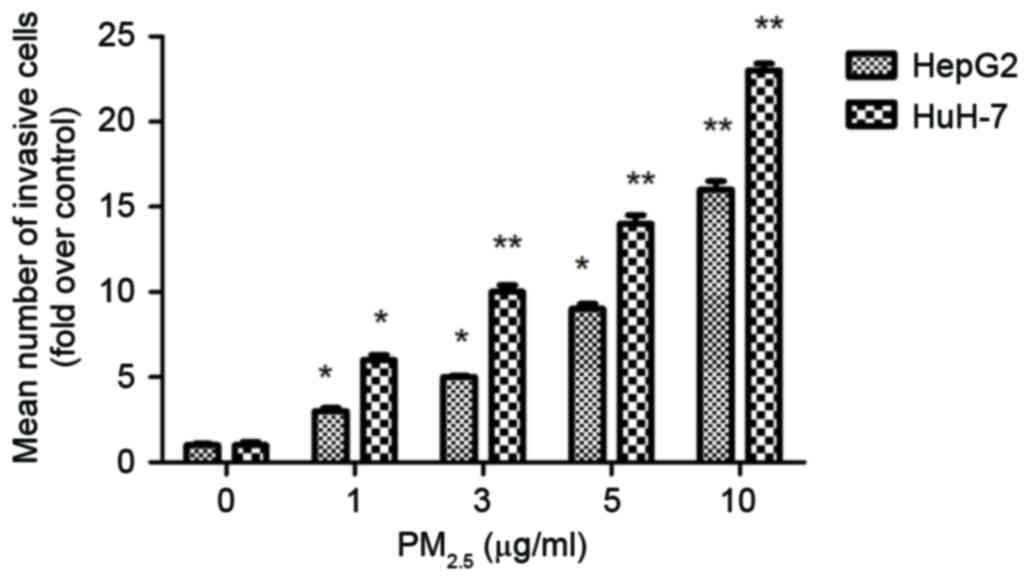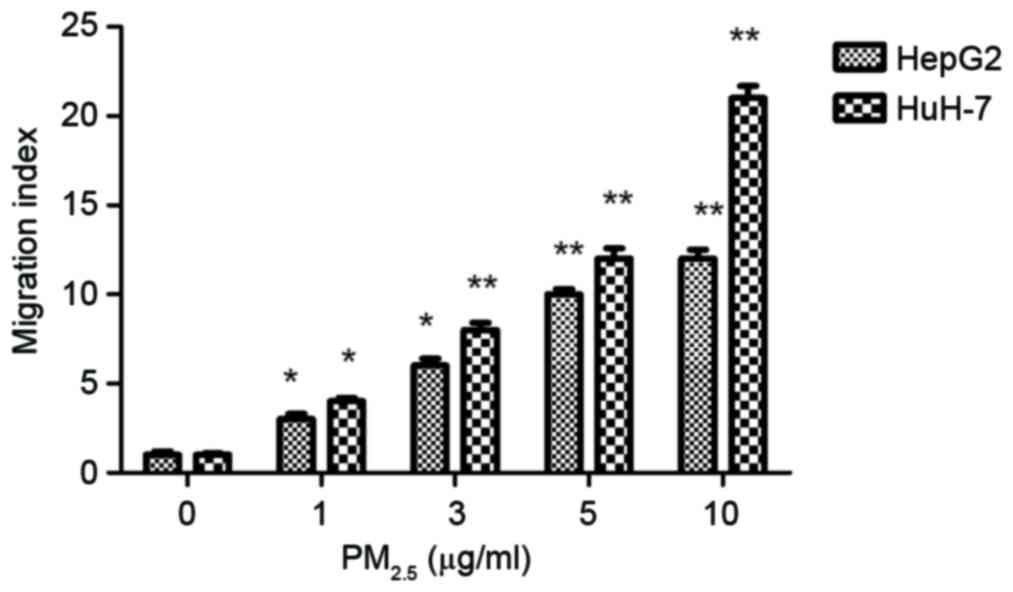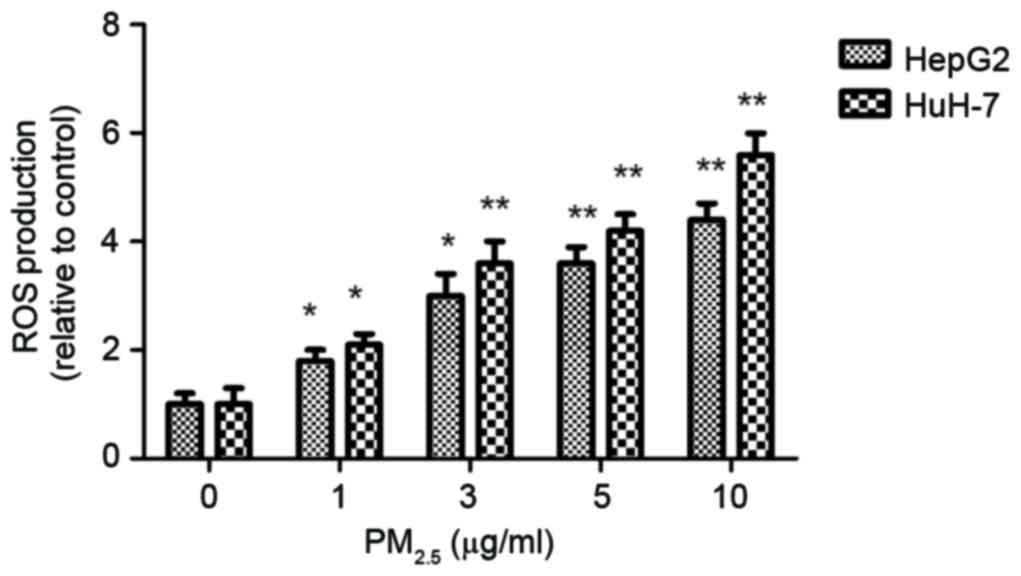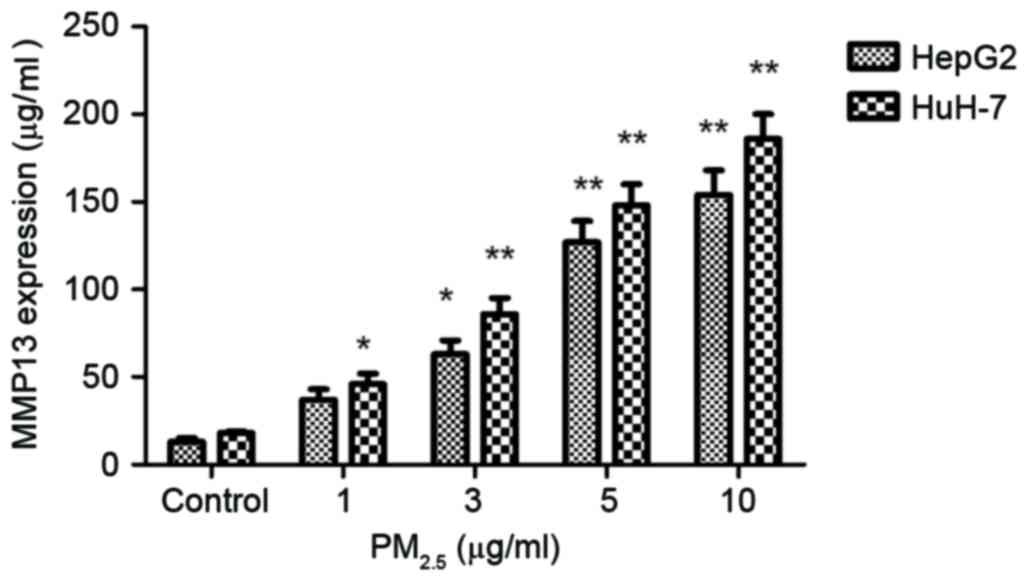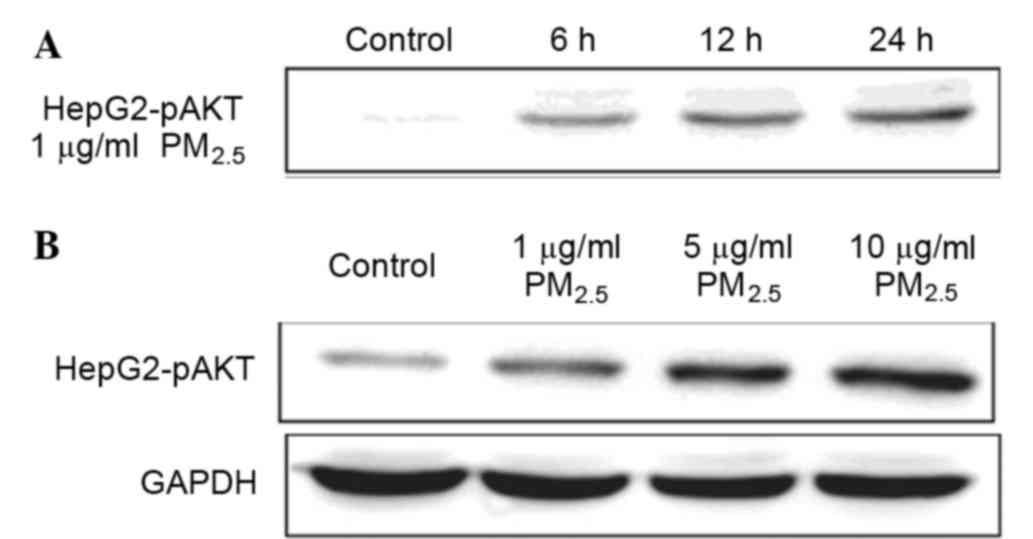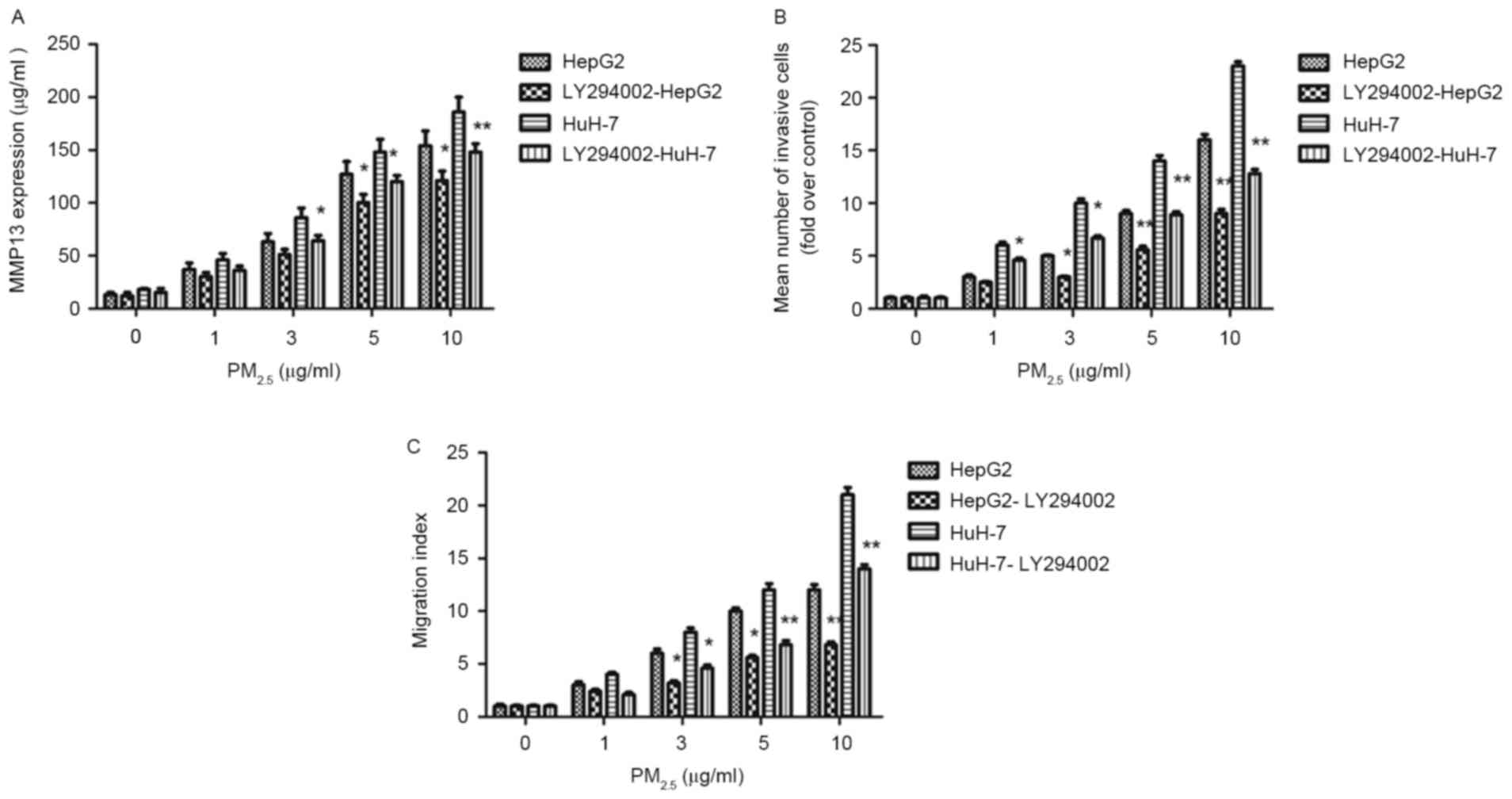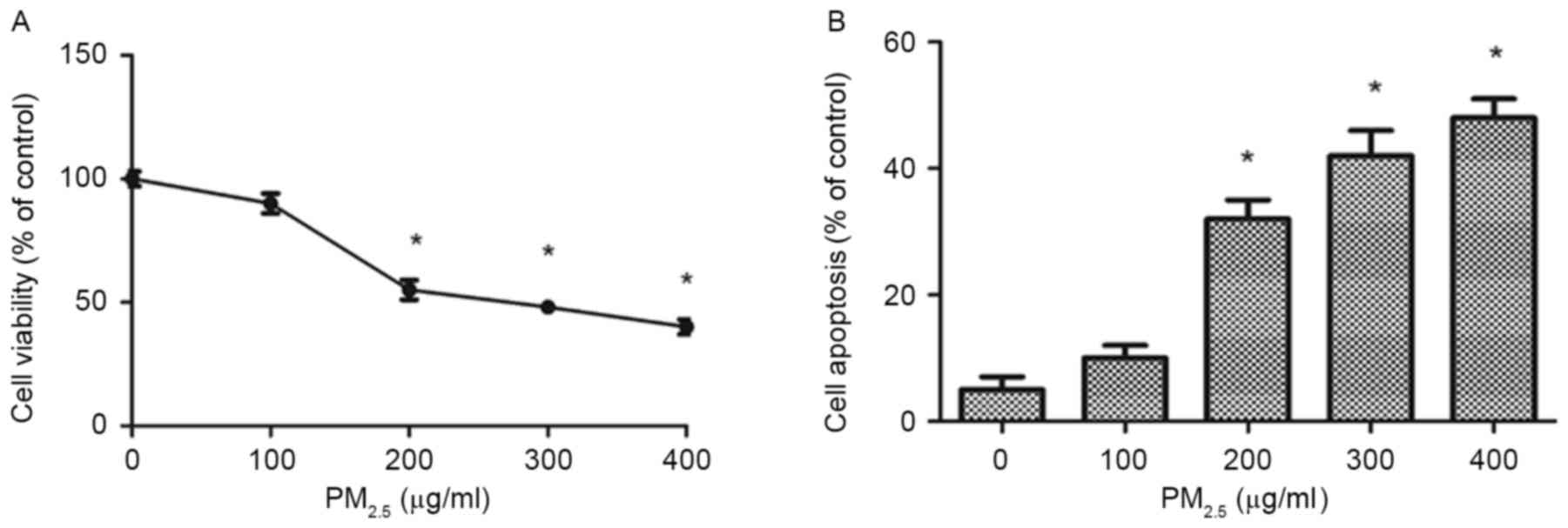Atmospheric particulate matter2.5 promotes the migration and invasion of hepatocellular carcinoma cells
- Authors:
- Published online on: March 29, 2017 https://doi.org/10.3892/ol.2017.5947
- Pages: 3445-3450
-
Copyright: © Zhang et al. This is an open access article distributed under the terms of Creative Commons Attribution License.
Abstract
Introduction
Particulate matter (PM), a key type of air pollutant, is regarded as a group 1 human carcinogen by the International Agency for Research on Cancer (1,2). A number of epidemiological studies have demonstrated an association between high concentrations of PM, particularly that with an aerodynamic diameter of <2.5 µm (PM2.5), and an increased risk of cancer development (3). In Northern China, coal combustion is used widely and extensively in rural areas for cooking and heating (4). The high concentration of PM2.5 caused by this type of energy production, and chemical and metallurgical industries, in the cities of China may cause serious health problems in the population (5).
Previous studies have demonstrated an association between PM2.5 and lung cancer cell metastasis (6,7). The results revealed that PM2.5 enhanced lung cancer cell migration and invasion, and promoted reactive oxygen species (ROS) levels -mediated extracellular matrix (ECM) degradation. However, the molecular mechanisms underlying PM2.5-induced carcinogenesis are not yet well understood.
Hepatocellular carcinoma (HCC) is one of the predominant causes of cancer-associated mortality worldwide (8). HCC cell metastasis is the primary cause of HCC development. HCC metastasis occurs through complex processes, including the migration and invasion of tumor cells (9,10). PM2.5 induced the metastatic capabilities of lung cancer, including migration and invasion (11). The patient observational reports indicated that PM2.5 exposure was associated with HCC via chronic liver inflammation (12). The incidence of HCC may also be associated with PM2.5, therefore the effects of PM2.5 on HCC cells require further study.
Aberrant ROS expression may lead to a number of physiological and pathological changes, such as cell cycle progression (13) and apoptosis (14,15). Notably, ROS can stimulate the expression of numerous metastatic factors, which leads to HCC cell migration and invasion (13,16). In addition, ROS production is an important etiological mechanism in PM2.5-induced tissue injury (17–19). However, whether PM2.5 affects HCC through the production of ROS is not yet known, to the best of our knowledge.
HCC metastasis occurs through a complex mechanism, during which matrix metalloproteinases (MMPs) are responsible for ECM degradation (20). MMP13 is overexpressed in numerous types of invasive tumors (21–23), suggesting that MMP13 may be associated with the cell migration and invasion induced by PM2.5.
The phosphoinositide 3-kinase (PI3K)-RAC-alpha serine/threonine-protein kinase (AKT) signaling pathway is important for the development of HCC (24,25). Activated AKT is necessary for the metastasis, proliferation and evasion of apoptosis of tumor cells, therefore the PI3K/AKT signaling pathway may be activated during PM2.5-mediated cancer cell migration and invasion.
The results from the present study demonstrate that PM2.5 induces HCC invasion and migration, and revealed that the underlying molecular mechanism involves the PI3K/AKT signaling pathway, which in turn promotes ROS and MMP13 expression.
Materials and methods
Preparation of ambient PM2.5 water-soluble extracts
A total of 50 mg of particulate matter 2.5 (PM2.5; SRM® 1650b; NIST, Boulder, CO, USA) was suspended in 5 ml PBS for 24 h at 37°C and sonicated at 40 W for 20 min. The PM2.5 suspension was centrifuged at 13,000 × g for 10 min at 4°C, and filtered using a 0.22-µm syringe filter.
Cell culture and exposure
The human HCC cell lines HepG2 and HuH-7, and human normal human HL7702 hepatocytes were purchased from the China Center for Type Culture Collection and were cultured in Dulbecco's modified Eagle's medium (DMEM) with 10% fetal bovine serum (FBS), 100 U/ml penicillin and 100 µg/ml streptomycin (all Invitrogen; Thermo Fisher Scientific, Inc., Waltham, MA, USA) in a humidified incubator with 5% CO2 at 37°C. LY294002 was purchased from Sigma Aldrich (#L9908; Merck KGaA, Darmstadt, Germany).
Cell invasion assay
HepG2 and HuH-7 cells (cultured at 37°C) invasion were measured using a 24-well Matrigel®-coated Transwell® assay, as previously described (26). Briefly, the upper surface of the filter was coated with Matrigel (1 mg/ml) at room temperature. Prior to the assay, HCC cells (5×105 cells/ml) were seeded into plates, 10 µg/ml PM2.5 was added and the plates were cultured for 24 h. The PM2.5-treated HCC cells were harvested, and 8×104 cells in DMEM were added to the upper chamber of the Transwell plate. DMEM medium with 10% FBS was added to the lower chamber. Cells were allowed to migrate through the Matrigel for 24 h. Migrated cells were fixed with 4% paraformaldehyde and stained with crystal violet.
Transwell migration assay
Cell migration was assessed using a Transwell assay. HCC cells (5×104) were incubated with PM2.5 at various doses (0–10 µg/ml) for 24 h prior to seeding into the upper chambers. DMEM containing 10% FBS was placed into the bottom chambers. Following 8 h of incubation, cells in the upper chamber that had not migrated were removed. The migrated cells were fixed with 4% paraformaldehyde and stained with crystal violet. Images were captured using an Olympus light microscope. A total of three independent experiments were performed. The migration index was defined as follows: (the migrated cells number in the experimental group/the migrated cells number in the control group) ×100.
ROS assay
A total of 5×105 cells/well of HepG2 or HuH-7 cells were seeded into 35 mm Petri dishes with DMEM containing 10% FBS. The cells were treated with PM2.5 at various doses (0–10 µg/ml) for 6 h. The cells were harvested, resuspended in DMEM and incubated with 2′,7′-dichlorofluoresceindiacetate (DCFH-DA; 10 µM) at 37°C for 30 min. The intracellular ROS levels were monitored at 488 nm (excitation) and 519 nm (emission) using a confocal fluorescence microscope and analyzed using flow cytometry. The data were processed using the FlowJo Vx 10.0 software (Tree Star Inc., Ashland, OR, USA).
ELISA
MMP13 levels of HepG2 and HuH-7 cells were determined using the Human MMP13 Quantitation ELISA kit (DM1300; R&D Systems, Inc., Minneapolis, MN, USA) according to the manufacturer's protocol. The optical density of the plates was read at 450 nm (excitation) and 540 nm (emission) using a microplate reader. The amount of MMP13 (µg/ml) was evaluated from a standard curve and expressed as µg/ml.
Western blotting
Total protein from HepG2 and HuH-7 cells was extracted using radioimmunoprecipitation assay lysis buffer containing 1% protease inhibitor cocktail (#5500; R&D Systems, Inc.). The proteins (40 µg) were separated by SDS-PAGE and transferred onto a polyvinylidene fluoride membrane (Bio-Rad Laboratories, Inc., Hercules, CA, USA). The membranes were incubated for 1 h at room temperature with 5% nonfat milk to block nonspecific binding and then incubated with the primary antibodies, including GAPDH (dilution, 1:100; #2118; Cell Signaling Technology, Inc., Dancers, MA, USA) and p-AKT (dilution, 1:100; #4058; Cell Signaling Technology, Inc.) overnight at 4°C. Following washing with Tris-buffered saline with 0.1% Tween-20, the membranes were incubated with the anti-rabbit (#W4011) or anti-mouse (#W4021) immunoglobulin conjugated to horseradish peroxidase secondary antibody (dilution, 1:500; Promega Corporation, Madison, WI, USA) for 1 h at room temperature. The blots were visualized using enhanced chemiluminescence kit (#32106, Thermo Fisher Scientific, Inc.).
Cytotoxicity assay
HL7702 cell viability was measured using the Cell Counting Kit-8 (CCK-8; Dojindo Molecular Technologies, Inc., Kumamoto, Japan) according to the manufacturer's protocol. HL7702 cells (5×103 cells/well) were seeded into 96-well plates overnight and then treated with serial concentrations of PM2.5 (0–400 µg/ml) for 24 h. A total of 10 µl of CCK-8 solution was added to each well for 1 h, and the absorbance at 450 nm was measured using a microplate reader and analyzed using Image-Pro Plus 6.0 software (Media Cybernetics, Inc., Shanghai, China).
Apoptosis assay
Cell apoptosis was detected using the Annexin V-fluorescein isothiocyanate (FITC)/propidium iodide (PI) assay. HL7702 cells (2×105 cells/well) were seeded into 6-well plates and treated with PM2.5 (0–400 µg/ml) for 24 h. Apoptotic cells were then identified using an Annexin V-FITC apoptosis detection kit (BD Biosciences), according to the manufacturer's protocol. Flow cytometry data were performed using the CellQuest software (BD Biosciences, San Jose, CA, USA).
Statistical analysis
The data are presented as the mean ± standard deviation of three independent experiments. All analyses were performed using analysis of variance tests followed by a Fisher's least significant difference test. P<0.05 was considered to indicate a statistically significant difference.
Results
PM2.5 induces HCC cell invasion
Matrigel chamber assays were used to investigate the role of PM2.5 in cell invasion. Following PM2.5 exposure, the number of HCC cells that migrated from the upper chamber to the lower chamber compared with the control (untreated cells) was significantly increased (Fig. 1), which suggested that PM2.5 promotes HCC invasion.
PM2.5 induces HCC cell migration
To evaluate the effect of PM2.5 on cell motility, cell migration assays were carried out using a Transwell assay. Following exposure to PM2.5 (1–10 µg/ml) for 24 h, the number of cells that migrated significantly increased compared with the control (Fig. 2). PM2.5 stimulated HCC cell migration in a dose-dependent manner.
PM2.5 induces ROS production in HCC cells
To investigate the involvement of ROS in PM2.5-induced HCC metastasis, ROS levels were measured following exposure to PM2.5 for 6 h. The DCFH-DA staining data demonstrated that PM2.5 significantly induces ROS overproduction compared with the control (Fig. 3).
Underlying molecular mechanisms of PM2.5-induced HCC cell migration and invasion
The expression of MMP13 was measured following PM2.5 stimulation. The expression of MMP13 was positively associated with the PM2.5 dose (1–10 µg/ml) in HepG2 cells (Fig. 4). In addition, MMP13 expression in HCC cells increased significantly following PM2.5 treatment compared with the control.
To test whether the PI3K/AKT signaling pathway was involved in the response to PM2.5 exposure in HCC cells, HepG2 cells were treated with PM2.5 at different doses and time points. AKT phosphorylation increased 6 h following PM2.5 exposure (Fig. 5). The data revealed that PM2.5 increased levels of phosphorylated AKT in a dose-dependent manner.
LY294002 significantly suppressed the MMP13 protein expression induced by PM2.5 (Fig. 6A), in addition to the increased invasion (Fig. 6B) and migration (Fig. 6C) induced by PM2.5. These data indicate that the inhibition of the AKT signaling pathway reduces MMP13 expression, and may suppress PM2.5-induced HCC migration and invasion.
High concentrations of PM2.5 decreases HL7702 proliferation in a dose-dependent manner
The CCK-8 assay results revealed that 200, 300 and 400 µg/ml PM2.5 significantly reduced HL7702 viability following exposure for 24 h compared with the control group. The half-maximal inhibitory concentration (IC50) value of PM2.5 was 200 µg/ml (Fig. 7A).
High concentrations of PM2.5 induces HL7702 apoptosis in a dose-dependent manner
The Annexin V-FITC/PI double staining assays demonstrated that PM2.5 induced apoptosis in HL7702 cells in a dose-dependent manner (Fig. 7B). In addition, 200–400 µg/ml PM2.5 significantly increased the rate of apoptosis in HL7702 cells following exposure for 24 h compared with the control group.
Discussion
The aim of the present study was to explore the effect of PM2.5 on the invasion and migration of HCC cells, and to identify the underlying mechanisms of this effect. The results from the present study demonstrated that PM2.5 could induce the migration and invasion of HCC cells. Additionally, PM2.5 increased ROS and MMP13 production in a dose-dependent manner. Western blotting results indicated that the activation of the AKT signaling pathway may be involved in these effects of PM2.5. The results from the present study suggest that PM2.5 promotes the development of HCC via inducing cell invasion and migration.
Invasion and metastasis are typical characteristics of HCC and a contributing factor to the poor prognosis of patients with HCC. PM2.5 exposure was associated with the risk of developing HCC and PM2.5 exposure induced inflammation cytokine levels that may contributed to HCC risk. Considering the frequent occurrence of metastasis in patients with HCC, the association of PM2.5 exposure with HCC cell invasion and migration requires further study. HCC cell invasion is the first step for distant metastasis, therefore increased HCC cell invasion may have a significant effect on tumor development. The data from the present study demonstrated that PM2.5 exposure significantly promoted HCC migration and invasion in a dose-dependent manner.
ROS production has been revealed to serve an important role in mediating the cytotoxic effects of PM2.5. Exposure to PM2.5 is regarded as a cardiovascular risk factor via ROS overproduction (27), but whether it promotes HCC via inducing ROS production remains unclear. In the present study, PM2.5 significantly increased HCC cell production of ROS in a dose-dependent manner.
MMP13 serves a crucial role in HCC invasion and metastasis, and has demonstrated to serve a role in the chronic inflammatory response (28). MMP13 mediates the release of inflammatory cytokines (21). Tumor necrosis factor (TNF)-α is a proinflammatory cytokine that serves a role in the pathogenesis of numerous diseases, including HCC (29). Therefore, PM2.5 is likely to promote HCC development by affecting MMP13 expression, which could promote cancer invasion and migration, in addition to promoting the expression of inflammatory cytokines. This hypothesis is supported by a previous study, which revealed that PM2.5 is associated with inflammatory cytokines as it induces TNF-α expression (30).
Previous studies have demonstrated that the PI3K/AKT signaling pathway is associated with MMP13 expression (31). Additionally, the data from the present study revealed that the PI3K/AKT signaling pathway was activated in PM2.5-treated HCC cells. The AKT inhibitor LY294002 significantly decreased PM2.5-induced MMP13 overexpression in HCC cells. These findings suggest that PM2.5-induced MMP13 upregulation is dependent on the PI3K/AKT signaling pathway. The data also revealed that PM2.5 effectively inhibited proliferation of HL7702 cells in vitro with an IC50 value of 200 µg/ml.
In conclusion, the present study demonstrated that exposure to PM2.5 promotes the migration and invasion of HCC cells. The present study also highlighted the role of the PI3K/AKT signaling pathway and MMP13 expression in regulating PM2.5-induced HCC cell migration and invasion. The results demonstrating that PM2.5 exposure promotes the invasion and migration ability of HCC cells provides an insight into the association between a higher incidence of HCC and PM2.5 exposure. Further studies are required to address the chronic exposure to higher PM2.5 levels on the effect of public health.
Acknowledgements
The present study was supported by the Provisions of Shanghai Municipality on Science and Technology Awards from the Shanghai Municipal Science and Technology Commission (grant no. 2013sy036).
References
|
Hou X, Strickland MJ and Liao KJ: Contributions of regional air pollutant emissions to ozone and fine particulate matter-related mortalities in eastern U.S. urban areas. Environ Res. 137:475–484. 2015. View Article : Google Scholar : PubMed/NCBI | |
|
Eze IC, Schaffner E, Fischer E, Schikowski T, Adam M, Imboden M, Tsai M, Carballo D, von Eckardstein A, Künzli N, et al: Long-term air pollution exposure and diabetes in a population-based Swiss cohort. Environ Int. 70:95–105. 2014. View Article : Google Scholar : PubMed/NCBI | |
|
Chow JC: Health effects of fine particulate air pollution: Lines that connect. J Air Waste Manag Assoc. 56:707–708. 2006. View Article : Google Scholar : PubMed/NCBI | |
|
Loomis D, Grosse Y, Lauby-Secretan B, El Ghissassi F, Bouvard V, Benbrahim-Tallaa L, Guha N, Baan R, Mattock H and Straif K: International Agency for Research on Cancer Monograph Working Group IARC: The carcinogenicity of outdoor air pollution. Lancet Oncol. 14:1262–1263. 2013. View Article : Google Scholar : PubMed/NCBI | |
|
Loomis D, Huang W and Chen G: The International Agency for Research on Cancer (IARC) evaluation of the carcinogenicity of outdoor air pollution: Focus on China. Chin J Cancer. 33:189–196. 2014. View Article : Google Scholar : PubMed/NCBI | |
|
Boström CE, Gerde P, Hanberg A, Jernström B, Johansson C, Kyrklund T, Rannug A, Törnqvist M, Victorin K and Westerholm R: Cancer risk assessment, indicators, and guidelines for polycyclic aromatic hydrocarbons in the ambient air. Environ Health Perspect. 110:(Suppl 3). S451–S488. 2002. View Article : Google Scholar | |
|
Xia Z, Duan X, Tao S, Qiu W, Liu D, Wang Y, Wei S, Wang B, Jiang Q, Lu B, et al: Pollution level, inhalation exposure and lung cancer risk of ambient atmospheric polycyclic aromatic hydrocarbons (PAHs) in Taiyuan, China. Environ Pollut. 173:150–156. 2013. View Article : Google Scholar : PubMed/NCBI | |
|
Tang D, Sun B, Yu H, Yang Z and Zhu L: Tumor-suppressing effect of miR-4458 on human hepatocellular carcinoma. Cell Physiol Biochem. 35:1797–1807. 2015. View Article : Google Scholar : PubMed/NCBI | |
|
Gores GJ: Decade in review-hepatocellular carcinoma: HCC-subtypes, stratification and sorafenib. Nat Rev Gastroenterol Hepatol. 11:645–647. 2014. View Article : Google Scholar : PubMed/NCBI | |
|
Zhang X, Ng HL, Lu A, Lin C, Zhou L, Lin G, Zhang Y, Yang Z and Zhang H: Drug delivery system targeting advanced hepatocellular carcinoma: Current and future. Nanomedicine. 12:853–869. 2016. View Article : Google Scholar : PubMed/NCBI | |
|
Shu Y, Zhu L, Yuan F, Kong X, Huang T and Cai YD: Analysis of the relationship between PM2.5 and lung cancer based on protein-protein interactions. Comb Chem High Throughput Screen. 19:100–108. 2016. View Article : Google Scholar : PubMed/NCBI | |
|
Pan WC, Wu CD, Chen MJ, Huang YT, Chen CJ, Su HJ and Yang HI: Fine Particle Pollution, Alanine Transaminase, and Liver Cancer: A Taiwanese Prospective Cohort Study (REVEAL-HBV). J Natl Cancer Inst. 108:pii: djv341. 2015. View Article : Google Scholar : PubMed/NCBI | |
|
Deng G, Hu C, Zhu L, Huang F, Huang W, Xu H and Nie W: Downregulation of ROS-FIG inhibits cell proliferation, colony formation, cell cycle progression, migration and invasion, while inducing apoptosis in intrahepatic cholangiocarcinoma cells. Int J Mol Med. 34:661–668. 2014.PubMed/NCBI | |
|
Shao J, Xue J, Dai Y, Liu H, Chen N, Jia L and Huang J: Inhibition of human hepatocellular carcinoma HepG2 by phthalocyanine photosensitiser PHOTOCYANINE: ROS production, apoptosis, cell cycle arrest. Eur J Cancer. 48:2086–2096. 2012. View Article : Google Scholar : PubMed/NCBI | |
|
Hou YQ, Yao Y, Bao YL, Song ZB, Yang C, Gao XL, Zhang WJ, Sun LG, Yu CL, Huang YX, et al: Juglanthraquinone C Induces Intracellular ROS Increase and Apoptosis by Activating the Akt/Foxo Signal Pathway in HCC Cells. Oxid Med Cell Longev. 2016:49416232016. View Article : Google Scholar : PubMed/NCBI | |
|
Adhikary A, Mohanty S, Lahiry L, Hossain DM, Chakraborty S and Das T: Theaflavins retard human breast cancer cell migration by inhibiting NF-kappaB via p53-ROS cross-talk. FEBS Lett. 584:7–14. 2010. View Article : Google Scholar : PubMed/NCBI | |
|
Zhou W, Tian D, He J, Wang Y, Zhang L, Cui L, Jia L, Zhang L, Li L, Shu Y, et al: Repeated PM2.5 exposure inhibits BEAS-2B cell P53 expression through ROS-Akt-DNMT3B pathway-mediated promoter hypermethylation. Oncotarget. 7:20691–21703. 2016.PubMed/NCBI | |
|
Torres-Ramos YD, Montoya-Estrada A, Guzman-Grenfell AM, Mancilla-Ramirez J, Cardenas-Gonzalez B, Blanco-Jimenez S, Sepulveda-Sanchez JD, Ramirez-Venegas A and Hicks JJ: Urban PM2.5 induces ROS generation and RBC damage in COPD patients. Front Biosci (Elite Ed). 3:808–817. 2011.PubMed/NCBI | |
|
Verma V, Fang T, Xu L, Peltier RE, Russell AG, Ng NL and Weber RJ: Organic aerosols associated with the generation of reactive oxygen species (ROS) by water-soluble PM2.5. Environ Sci Technol. 49:4646–4656. 2015. View Article : Google Scholar : PubMed/NCBI | |
|
Wang YH, Sui XM, Sui YN, Zhu QW, Yan K, Wang LS, Wang F and Zhou JH: BRD4 induces cell migration and invasion in HCC cells through MMP-2 and MMP-9 activation mediated by the Sonic hedgehog signaling pathway. Oncol Lett. 10:2227–2232. 2015.PubMed/NCBI | |
|
Yang Z, Zhang Y and Wang L: A feedback inhibition between miRNA-127 and TGFβ/c-Jun cascade in HCC cell migration via MMP13. PLoS One. 8:e652562013. View Article : Google Scholar : PubMed/NCBI | |
|
Kotepui M, Thawornkuno C, Chavalitshewinkoon-Petmitr P, Punyarit P and Petmitr S: Quantitative real-time RT-PCR of ITGA7, SVEP1, TNS1, LPHN3, SEMA3G, KLB and MMP13 mRNA expression in breast cancer. Asian Pac J Cancer Prev. 13:5879–5882. 2012. View Article : Google Scholar : PubMed/NCBI | |
|
Shah M, Huang D, Blick T, Connor A, Reiter LA, Hardink JR, Lynch CC, Waltham M and Thompson EW: An MMP13-selective inhibitor delays primary tumor growth and the onset of tumor-associated osteolytic lesions in experimental models of breast cancer. PLoS One. 7:e296152012. View Article : Google Scholar : PubMed/NCBI | |
|
Wang Y, Huang X, Han J, Zheng W and Ma W: Extract of Perilla frutescens inhibits tumor proliferation of HCC via PI3K/AKT signal pathway. Afr J Tradit Complement Altern Med. 10:251–257. 2013.PubMed/NCBI | |
|
Sui Y, Zheng X and Zhao D: Rab31 promoted hepatocellular carcinoma (HCC) progression via inhibition of cell apoptosis induced by PI3K/AKT/Bcl-2/BAX pathway. Tumour Biol. 36:8661–8670. 2015. View Article : Google Scholar : PubMed/NCBI | |
|
Li W, Jiang G, Zhou J, Wang H, Gong Z, Zhang Z, Min K, Zhu H and Tan Y: Down-regulation of miR-140 induces EMT and promotes invasion by targeting Slug in esophageal cancer. Cell Physiol Biochem. 34:1466–1476. 2014. View Article : Google Scholar : PubMed/NCBI | |
|
Cao J, Qin G, Shi R, Bai F, Yang G, Zhang M and Lv J: Overproduction of reactive oxygen species and activation of MAPKs are involved in apoptosis induced by PM2.5 in rat cardiac H9c2 cells. J Appl Toxicol. 36:609–617. 2016. View Article : Google Scholar : PubMed/NCBI | |
|
Jin D, Tao J, Li D, Wang Y, Li L, Hu Z, Zhou Z, Chang X, Qu C and Zhang H: Golgi protein 73 activation of MMP-13 promotes hepatocellular carcinoma cell invasion. Oncotarget. 6:33523–33533. 2015.PubMed/NCBI | |
|
Ji Y, Wang Z, Li Z, Zhang A, Jin Y, Chen H and Le X: Angiotensin II Enhances Proliferation and Inflammation through AT1/PKC/NF-κB Signaling Pathway in Hepatocellular Carcinoma Cells. Cell Physiol Biochem. 39:13–32. 2016. View Article : Google Scholar : PubMed/NCBI | |
|
Tong GQ, Zhang ZH, Zhao Y, Liu JJ and Han JB: Traffic-related PM2.5 induces cytosolic [Ca2+] increase regulated by Orai1, alters the CaN-NFAT signaling pathway, and affects IL-2 and TNF-α cytoplasmic levels in Jurkat T-cells. Arch Environ Contam Toxicol. 68:31–37. 2015. View Article : Google Scholar : PubMed/NCBI | |
|
Xu L, Sun K, Xia M, Li X and Lu Y: MMP13 regulates aggressiveness of pediatric multiple myeloma through VEGF-C. Cell Physiol Biochem. 36:509–516. 2015. View Article : Google Scholar : PubMed/NCBI |



